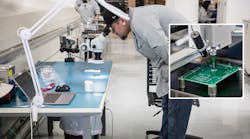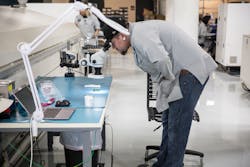What you’ll learn:
- Best practices on how to work with a manufacturer to mitigate PCBA manufacturing complexity and, ultimately, get your designs to market faster than the competition.
- Steps in the PCBA manufacturing process.
- Procedures on how to minimize complexity.
Many electronics engineers have an “I’ll know it when I see it” way of dealing with problems when designing prototype circuit boards. However, when working with a contract manufacturer (CM) for printed-circuit-board assembly (PCBA), there’s nothing to “see,” and as a result, not much insight on why a board was or will be complex to manufacture.
Understanding PCBA manufacturing complexity is crucial to identifying—and mitigating—the top drivers of lead time, cost, and predictability for different PCBA designs. For the design engineer, these complexities can be generalized using the concepts of “build” (i.e., “What does it take to complete each process?), and “recovery” (i.e., “What are the steps needed due to a process failure?”).
Breaking Down the PCBA Manufacturing Process
The PCBA manufacturing process can be broken down into the Printed Circuit Fabrication Process (the bare fab) and the Assembly Process (adding components, etc., to the substrate), both of which have a build process and a possible recovery process. The build process details steps for construction of the board, while the recovery process includes the steps needed to recover from any defects that are discovered.
The Build Process
The specific number of steps in the build process and the complexity of each individual step is determined by the design’s build specification. Understandably, as the number of steps and the complexity of each step increase, so does the overall complexity of the board build. In addition, each additional step of the build process also increases labor hours, project-management overhead, and opportunities for defects.
Thus, to reduce costs and shorten the timeline, it’s important for designers to consider ways to minimize the number of steps in the build process. Besides cost and time savings, doing so also increases predictability, as fewer steps leave less room for defects.
The Recovery Process
For each step in the build process, there’s a chance for defects to occur, and they will ultimately need to be righted in the recovery process. While recovery can be as simple as a few touch-ups, it can, like the build process, grow in complexity and even require completely scrapping the build and starting over. The recovery process will become costlier and lengthier for designers based on the likelihood of defect, the number of steps needed to recover from a given defect, and the complexity of each of these steps.
A successful board build, then, requires not only an optimized build process, but also a carefully prepared recovery process.
Build and Recovery in Fabrication versus in Assembly
While the build and recovery processes drive intricacy during both fabrication and assembly, they manifest differently in each process.
For example, many consider it “easier” to control the assembly process than the fabrication process. This is primarily due to the number of chemical processes included in the fabrication process as compared to assembly.
Because most of the build-process steps in the assembly process are mechanical instead of chemical, the assembly process also has lower technique complexity and, thus, greater controllability. Moreover, the assembly process typically comprises fewer build steps than the fabrication process, so it generally has a lower overall build complexity.
The assembly process usually has a more flexible recovery process than does the fabrication process. During assembly, most discovered defects can be reworked, while defects discovered during the fabrication process are more likely to require a scrap event and prior (already completed) steps to be repeated.
In some cases, reworking can be equally or more laborious and expensive than repeating prior steps if the defects are challenging to correct or require replacement components. This can further add to the recovery-process timeline.
Minimizing Complexity: Why it’s Important
Minimizing complexity is essential for a successful board build. That’s because defects in the build or recovery processes of both fabrication and assembly drive expenditures and extend the overall manufacturing timeline.
Even just one defect could require a complete restart of the fabrication and/or assembly process. Unfortunately, in many cases, it isn’t always possible to identify the defect until very late in the process. For example, the final validation of impedance using time domain reflectometer (TDR) is run at the end of the manufacturing process. If the test fails, the whole process must be restarted, resetting the lead time.
For manufacturers, conducting tests during PCBA manufacturing presents a catch-22: If they conduct too many tests, they slow down the entire manufacturing process, costing time and money. If they conduct too few tests, they increase the risks and possible costs associated with finding defects late in the process.
Put simply: The greater the complexity, the longer the lead time, the higher the costs, and the more challenging the manufacturing process becomes.
How Engineers Can Work with Their CMs to Minimize Complexity
For engineers seeking to optimize their PCBA manufacturing process, engaging early with their CM will put them in the best position to understand and minimize the complexities in their designs before too many decisions have been committed. By consulting with their CM, engineers can see which build specifications are increasing process steps and those that are not. The CM can also provide insight into the complexity of the recovery process, identifying the risks associated with each step of the build process and what their potential recovery processes would look like.
To complete a successful board build, engineers must work closely with their CMs to identify and minimize complexities throughout the build and recovery processes of both fabrication and assembly. Doing so will reduce the chance of defects, cut back on costs, and streamline the manufacturing timeline, enabling engineers to bring their innovations to market faster.

